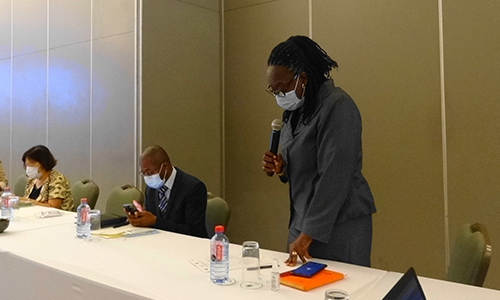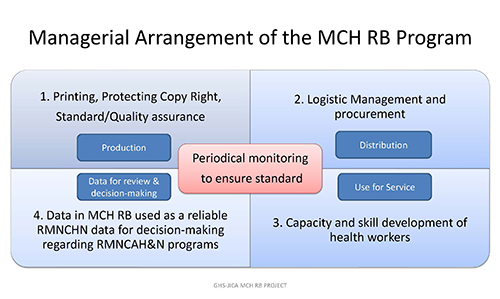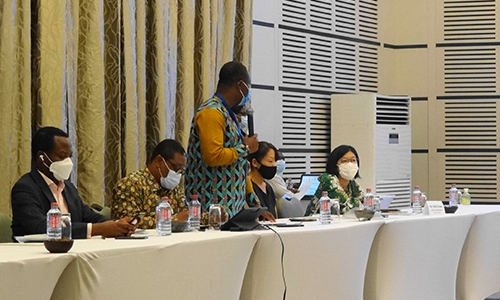- Home
- Technical Cooperation Projects
- Index of Countries
- Africa
- Ghana
- Project for Improving Continuum of Care for Mothers and Children through the introduction of Combined MCH Record Book
- Project News
- The 3rd Stakeholder Workshop for the Development of the MCH RB Management Guide
Project News
2021-06-10
The 3rd Stakeholder Workshop for the Development of the MCH RB Management Guide
The third Stakeholder Workshop for the Development of the MCH RB Management Guide was conducted on 10 June 2021 at Labadi Beach Hotel in Accra. Twenty-nine stakeholders from Family Health Division, Public Health Division and Store, Supplies and Drug Management Division of GHS HQ, Ashanti Regional Health Directorate (RHD), Central RHD, Ministry of Health, Christian Health Association of Ghana (CHAG), Ghana Association of Quasi Government Health Institutions (GAQHI), Society of Private Medical & Dental Practitioners, WHO, UNICEF, JICA Ghana office and MCH RB Project members attended the workshop to discuss outstanding critical issues on Management Guide for consensus-building, to discuss current needs and challenges with sustained supply and management of the MCH RB and to propose solutions to these.
Remarks
The workshop started with opening remarks by Dr. Isabella Sagoe Moses, Deputy Director, Reproductive and Child Health, Family Health Division, GHS, to stress the importance of a management guide for the national rollout of the MCH RB and its sustainability. She has also stressed the necessity of consultation from our stakeholders and the need to reach an agreement on some outstanding issues. She encouraged all participants to participate in the discussion fully and reach our agreement.
Dr. Earnest Asiedu, Head, Quality Management Unit, Ministry of Health (MOH) explained that "Sustainability" is the key of MCH RB rollout and MoH has a role of resource mobilization as well as to coordinate with the agencies under the MOH and to make the Ghana book to be fully utilized at their facilities and services. Besides production and distribution, we should consider how we are going to ensure capacity. MCH RB is recognized as a part of Universal Health Coverage (UHC) and captured in the UHC road map. He concluded that capacity development with MCH RB is going to improve mother's and children's health and eventually may contribute to the reduction of MMR, IMR, and CMR.
Ms. Maki Ozawa, Senior Representative, JICA Ghana Office told that as the Project is going to end in January 2022, the sustainability and institutionalization of the MCH RB should be fully discussed and captured in the Management Guide. She continued that it is our great pleasure to support GHS on the development of the Management Guide and with other stakeholders. She also said that JICA is content to see various stakeholders present for this meeting: MOH, CHAG, private entities and other related organizations and she looks forward to having a fruitful discussion today.
Discussions
At the beginning of the workshop, Dr. Isabella Sagoe Moses presented the rationale and objectives of the management guide on MCH RB. MCH RB is the platform for various programs and organizations related to Reproductive, Maternal, Newborn, Child and Adolescent Health and Nutrition. Therefore, key processes for procurement, distribution, monitoring, reproduction of the book need to be understood by all stakeholders. The objective of the management guide is to introduce rules and regulations related to the national rollout of the MCH RB as a reference document and to promote the MCH RB program with sustainability.
The content of the management guides is as follows,
- Introduction of Management Guide
- Implementation and Decision-Making Structure
- Production and Reproduction of MCH RB
- Logistic Management of MCH RB
- Monitoring and Supervision of Utilization of the MCH RB
- Use of the MCH RB as a source of reliable data of RMNCAH&N
Following the presentation, Ms. Esi Amoaful, Deputy Director, Nutrition, Family Health Division, GHS, and Dr. Akiko Hagiwara, MCH RB Project explained four dimensions of the discussion points; production of MCH RB, distribution of MCH RB, utilization of MCH RB at services and use data of MCH RB and reporting. The participants discussed several issues based on these dimensions.
Production of MCH RB
In terms of production, how to avoid shortage and maintenance of the standard were mainly discussed.
Although a large number of MCH RB were produced for the last three years, the demands exceeded, and the shortage is still a serious challenge. Due to the shortage of the MCH RB, some facilities made photocopies of the book, which led to black-and-white photocopied books, smaller books or books without full contents. Therefore, a representative from RHD proposed to discuss a kind of penalty for out-of-standard reproduction to protect the quality of the book.
Currently, MCH RB is distributed free of charge for all, and it is prohibited to sell the books. However, the books are sold at some facilities. The private sector insisted that it is necessary to charge the cost of MCH RB to the clients to secure the supply and the quality and thus an appropriate procurement process should be fixed and shown in the management guide. It was also suggested that the cost for the printing should be shared with the local government as well as with the clients and further discussion was suggested to examine the feasibility.
Many participants agreed that the printing should be centralized, and resources should be collected to the central levels for the protection of the copyright as well as for the cost implications. It was suggested to develop a framework such as GHS to contract a few selected printers for a fixed term with the pre-fixed unit cost and specification for the printing of the MCH RB and all parties who want to print the books can make orders to the selected printers with the pre-fixed unit cost regardless the number of the books and GHS HQ monitor it periodically. If partners are willing to support, they can directly contact the selected printer or have to get approval from the GHS to assure the quality of the printing. A participant added that some District Assemblies and big hospitals can print the books by themselves, while other weak districts and facilities may need supports.
Distribution of MCH RB
In terms of the distribution, logistic management and the issues on the distribution criteria were discussed.
The Director of the Store, Supplies and Drug Management Division proposed to use Ghana Integrated Logistics Management Information System (GhiLMIS), which was recently introduced for commodity management in Ghana, and the existing Last Mile Distribution system for the stock management of the books at the central and regional level.
Currently, the distribution criteria are for pregnant women and children under 1 year. However, some districts and facilities have been distributing books to children under 5 years, which has been accelerating the shortage of MCH RB. Therefore, a Program Manager of Safe Motherhood Program, said that the distribution criteria should be further clarified so that all pregnant women get books.
Utilization of MCH RB at services
The importance of the continuous capacity building of the health workers was highlighted for the MCH RB to be utilized effectively with the standard manners.
A Regional Director of Health explained that although the book should be utilized for risk identification, health workers sometimes miss the cases while they are recording the risks in the MCH RB. A Program officer of Safe Motherhood responded that we should take care of this point at the next major revision of the MCH RB. She noted that the book should be user-friendly and make it more visible for health workers to detect high-risk cases with color codes or pictorials. Dr. Earnest Asiedu, MOH, commented that further capacity building is needed to fill the gap of early detection and early treatment/referral and the private sectors should be fully involved in the training and meetings. Dr. Asiedu also added that MoH needs to seek an innovative way to arrange meetings and training to be conducted for convenient hours for the private sector.
Use data of MCH RB and reporting
A program officer, Safe motherhood program, said that data for decision-making related to RMNCH&N are collected through DHIMS which are consisted of facility-based data, such as a register. MCH RB is a client's health book, not the institutional records because clients keep them at home. Key information in the MCH RB is transcribed to the maternal health register or the child health and nutrition register, which are key assets of the reliable source of health records built in our health system. Dr. Hagiwara agreed that as the MCH RB is a home-based record and the registers are facility-based records, the objectives and functions of the MCH RB and facility registers are different and should be mentioned in the management guide. In Ghana, Reproductive, Maternal, Newborn, Child and Adolescent Health and Nutrition Strategic Plan (2020-2025) launched in December 2020, and it was proposed that the data of MCH RB can be a potential source of reliable data.
Private and Quasi-Governmental Facilities agreed that they will follow the standard procedures for production, distribution, utilization and reporting once those information and criteria were informed to them.
Way forward
At the end of the workshop, Dr. Kofi Issah, Director of FHD/ GHS stated the next steps. Today's discussion will be incorporated into the draft of the management guide within one week. And then the draft will be circulated to the members so that everyone can make additional inputs on it.
 Opening remarks from Dr. Isabella Sagoe Moses, Deputy Director, Reproductive and Child Health, Family Health Division, GHS
Opening remarks from Dr. Isabella Sagoe Moses, Deputy Director, Reproductive and Child Health, Family Health Division, GHS
 Managerial Arrangement of the MCH RB Program
Managerial Arrangement of the MCH RB Program
 Dr. Earnest Asiedu, MOH commented role of MoH
Dr. Earnest Asiedu, MOH commented role of MoH
- About JICA
- News & Features
- Countries & Regions
- Our Work
- Thematic Issues
- Types of Assistance
- Partnerships with Other Development Partners
- Climate Change / Environmental and Social Considerations
- Evaluations
- Compliance and Anti-corruption
- Science and Technology Cooperation on Global Issues
- Research
- JICA Development Studies Program / JICA Chair
- Support for the Acceptance of Foreign HRs / Multicultural and Inclusive Community
- Publications
- Investor Relations
